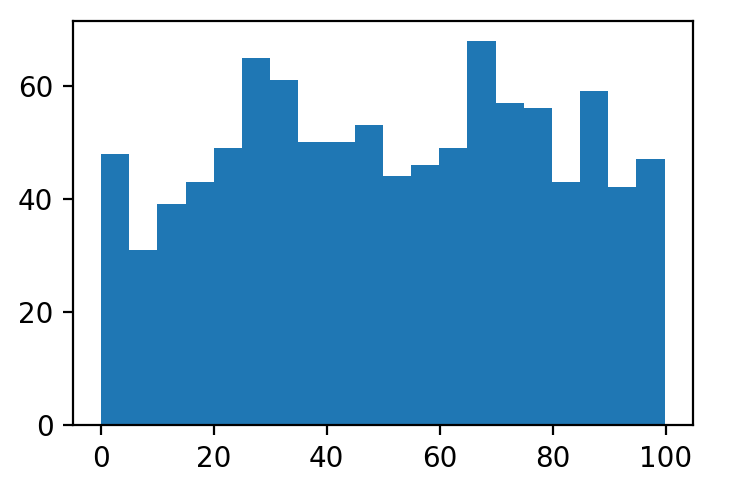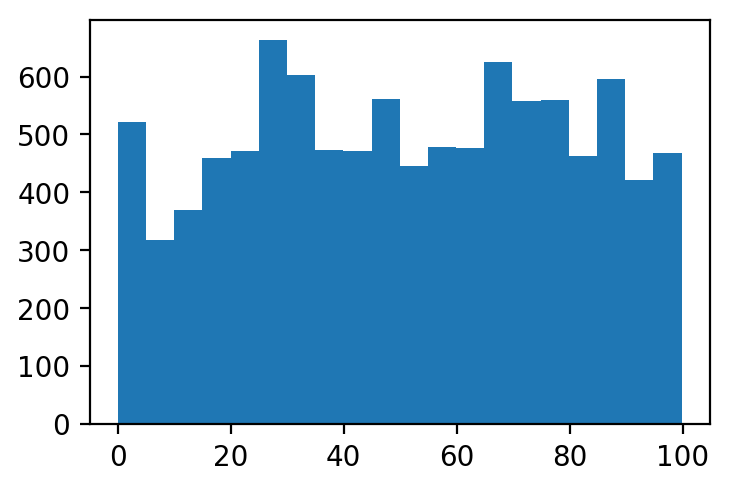Consider a stream of data that we receive, call them ![]() where
where ![]() is the
is the ![]() element in the stream. Note that we receive every
element in the stream. Note that we receive every ![]() at the
at the ![]() time step and that
time step and that ![]() is then no more in our access once we move on to the next time step. Furthermore, we don’t even know the value of
is then no more in our access once we move on to the next time step. Furthermore, we don’t even know the value of ![]() . How can we possibly uniformly sample an element from this stream? When I first thought about this, I was completely stuck; I couldn’t fathom any such procedure; to me, it just felt wrong that we needed to gain a uniform sample over
. How can we possibly uniformly sample an element from this stream? When I first thought about this, I was completely stuck; I couldn’t fathom any such procedure; to me, it just felt wrong that we needed to gain a uniform sample over ![]() samples without even knowing
samples without even knowing ![]() !
!
However, as the title implies, one method to accomplish this is called Reservoir Sampling. I’ll first introduce the mechanics directly, and don’t be discouraged if it doesn’t make sense since it can be quite non-intuitive at first. Before we delve into the mathematics, I recommend you take a look at this post, especially the basics of probability theory.
Development of the Theory
First, we let our stream be ![]() and we start by seeing
and we start by seeing ![]() and continue all the way to
and continue all the way to ![]() . Now consider the random variables
. Now consider the random variables ![]() defined by
defined by

In other words, we keep a reservoir sample and switch it to the current element we are reading with probability inverse to the current timestep, and the variables ![]() simply are the state of the reservoir at different timesteps. We claim that
simply are the state of the reservoir at different timesteps. We claim that
![]()
for all ![]() , i.e.
, i.e. ![]() is a uniformly distributed random variable from the sample space of all the stream elements. And in fact, we define
is a uniformly distributed random variable from the sample space of all the stream elements. And in fact, we define ![]() as our sample from the stream.
as our sample from the stream.
Now what confused me the most was that the probability that ![]() (fixing
(fixing ![]() ) is
) is ![]() is
is ![]() , but then somehow we concluded the probability that
, but then somehow we concluded the probability that ![]() remains as
remains as ![]() is
is ![]() . Seemingly confusing, right? We may select
. Seemingly confusing, right? We may select ![]() at the
at the ![]() timestep; however, we forget that we still need to not select the rest of the elements in order for
timestep; however, we forget that we still need to not select the rest of the elements in order for ![]() to remain
to remain ![]() . That part about not selecting other elements weighs into proving that
. That part about not selecting other elements weighs into proving that ![]() is uniformly distributed, and now we will see this in motion formally. I will provide a rigorous proof first, and then a more intuitive argument afterward.
is uniformly distributed, and now we will see this in motion formally. I will provide a rigorous proof first, and then a more intuitive argument afterward.
Claim: Defining ![]() and
and ![]() as we have, we claim
as we have, we claim
![]()
Proof: We prove the claim by induction on ![]() . First consider the case of
. First consider the case of ![]() where then we choose the first and only element of the stream with full probability, so obviously our selection is uniform.
where then we choose the first and only element of the stream with full probability, so obviously our selection is uniform.
Now consider some arbitrary ![]() , and assume the claim for the stream
, and assume the claim for the stream ![]() . Now add an element
. Now add an element ![]() to the stream, so our stream is
to the stream, so our stream is ![]() now. Now by definition
now. Now by definition ![]() with probability
with probability ![]() , so for all
, so for all ![]() :
:
![Rendered by QuickLaTeX.com \begin{align*} \Pr[X_{n + 1} = x_j] &= \Pr[(X_{n + 1} = X_n) \cap (X_n = x_j)] \\ &= \Pr[X_{n + 1} = X_n] \Pr[X_n = x_j \mid X_{n + 1} = X_n] \\ &= \Pr[X_{n + 1} = X_n] \Pr[X_n = x_j] \\ &= \lp1 - \frac{1}{n + 1}\rp \lp \frac{1}{n} \rp \\ &=\frac{n}{n + 1} \cdot \frac{1}{n} \\ &= \frac{1}{n + 1} \end{align*}](https://balaramdb.com/wp-content/ql-cache/quicklatex.com-45a3ea54b28cdfe9f9d241d415db08c3_l3.png)
as required. The second line is by Conditional Equivalence (details can be found here), the third by the independence of the reservoir’s state at a previous timestep, and the fourth derived from the inductive hypothesis. Furthermore, by definition we know ![]() . Thus we have shown for all
. Thus we have shown for all ![]() :
:
![]()
i.e. ![]() is an uniform sample from the stream
is an uniform sample from the stream ![]() as claimed; thus proving the correctness of Reservoir Sampling.
as claimed; thus proving the correctness of Reservoir Sampling. ![]()
A more intuitive approach, although less rigorous, is by writing
![Rendered by QuickLaTeX.com \begin{align*} \Pr[X_n = x_j] = \Pr[X_j = x_j] \cdot \prod_{i = j + 1}^n \Pr[X_i = X_{i - 1}] \end{align*}](https://balaramdb.com/wp-content/ql-cache/quicklatex.com-9b752a6ba813c3ed2148253d428d84a8_l3.png)
which is essentially the probability we select ![]() and then never select any other element of the stream. We can simplify:
and then never select any other element of the stream. We can simplify:
![Rendered by QuickLaTeX.com \begin{align*} \Pr[X_n = x_j] &= \frac{1}{j} \cdot \prod_{i = j + 1}^n \lp 1 - \frac{1}{i} \rp \\ &= \frac{1}{j} \cdot \prod_{i = j + 1}^n \lp \frac{i - 1}{i} \rp \\ &= \lp \frac{1}{j} \rp \lp \frac{j}{j + 1} \rp \cdots \lp \frac{n - 1}{n} \rp \\ &= \frac{1}{n} \end{align*}](https://balaramdb.com/wp-content/ql-cache/quicklatex.com-c6483580a9093bf06454ab467b4bb55f_l3.png)
as required, so we have shown that ![]() is uniform. This isn’t rigorous since we haven’t had a chance to discuss the relations between the random variables in order to get that initial product, and we never need to delve into that with our proof by induction.
is uniform. This isn’t rigorous since we haven’t had a chance to discuss the relations between the random variables in order to get that initial product, and we never need to delve into that with our proof by induction.
Verifying Reservoir Sampling
Now that we have understood the theory of Reservoir Sampling, let’s take a look at it in full motion. The following is the Python code for the Reservoir Sampling Algorithm.
def get_reservoir_sample(stream):
n = len(stream)
X = 0 # our sample
for i in range(n):
if rand.random() < 1/(i + 1):
X = stream[i]
return X
Now we generate a stream of 1,000 elements whose distribution is depicted in the following histogram.

Now after sampling 10,000 elements by the Reservoir Sampling, we arrive at the following distribution of samples.

Notice that the distributions are almost identical which verifies the uniformity of the Reservoir Sampling in practice.
I encourage you to try this for yourself and witness the power of Reservoir Sampling.
Practical Use of Reservoir Sampling
Common in most Streaming Algorithms, we tend to assume our stream to be extremely large, so storing the contents of the stream in memory is simply not viable. For example, consider a stream of posts from all CS blogs; obviously, storing each one in memory is a waste of space, but with Reservoir Sampling we can sample one post uniformly with ![]() space compared to
space compared to ![]() if we decided to keep all the posts.
if we decided to keep all the posts.
Furthermore, if we need ![]() independent samples from a stream, we can Reservoir Sample simultaneously and independently, so we can get our
independent samples from a stream, we can Reservoir Sample simultaneously and independently, so we can get our ![]() samples with only one pass through the stream. In practice, this method tends to be the preferred method of sampling as often we need more than just one sample.
samples with only one pass through the stream. In practice, this method tends to be the preferred method of sampling as often we need more than just one sample.
Also, there are more applications of this principle of keeping a reservoir (the ![]() samples) and replacing it with new stream elements as time passes, so look out for posts on this topic of streaming algorithms.
samples) and replacing it with new stream elements as time passes, so look out for posts on this topic of streaming algorithms.

Recent Comments